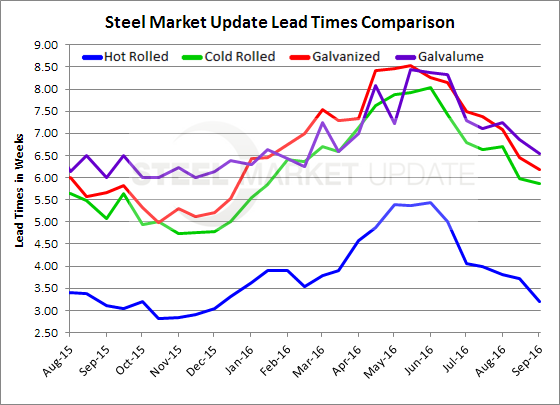SMU Data and Models

Domestic Mill Lead Times Slip Across the Board
Written by John Packard
September 8, 2016
The following information comes from our flat rolled steel market trends survey which began last Friday and concluded earlier today. Do not confuse our survey results with actual lead time sheets produced by individual steel mill locations. Based on what our respondents shared with SMU, lead times on hot rolled, cold rolled, galvanized and Galvalume all shrunk since our last analysis conducted during the middle of August 2016.
Even with the shrinkage in lead times, every product average for this week was still better than what we saw one year ago.
Hot rolled lead times were averaging more than 4 weeks as of the first week of July (4.07). HRC lead times are now averaging 3.19 weeks. In mid-August they were 3.73 weeks while one year ago the lead times on hot rolled coil averaged 3.11 weeks.
Cold rolled lead times also slipped. The new average for CRC is 5.87 weeks down almost one week compared to the beginning of August (6.71 weeks). One year ago cold rolled lead times averaged 5.08 weeks.
Galvanized lead times are averaging 6.19 weeks which is lower than the 6.45 measured during the middle of August and well below the 7.50 reported at the beginning of July. One year ago galvanized lead times averaged 5.66 weeks.
Galvalume lead times dropped to 6.55 weeks and are well below the 7.29 weeks reported at the beginning of July. One year ago AZ lead times were at 6.0 weeks.
As lead times retreat this puts pressure on the domestic steel mill order books. Shorter lead times are a signal of weaker spot prices in the flat rolled markets and that is what we have seen going back to early july.
A side note: The data for both lead times and negotiations comes from only service center and manufacturer respondents. We do not include commentary from the steel mills, trading companies, or toll processors in this particular group of questions.
To see an interactive history of our Steel Mill Negotiations data, visit our website here.

John Packard
Read more from John PackardLatest in SMU Data and Models

SMU Survey: Sheet lead times ease further, plate hits one-year high
Steel buyers responding to this week’s SMU market survey report a continued softening in sheet lead times. Meanwhile, plate lead times have moderately extended and are at a one-year high.

SMU Survey: Buyers report more price flexibility from mills
Nearly half of the steel buyers responding to this week’s SMU market survey say domestic mills are showing increased willingness to negotiate pricing on new spot orders. This marks a significant shift from the firmer stance mills held in prior weeks.

SMU Survey: Buyers’ Sentiment Indices fall
Current Sentiment Index dropped six points to +42 this week compared to two weeks earlier. It has fallen in every successive survey since reaching a 2025 high of +66 on Feb. 19.

March service center shipments and inventories report
Steel service center shipments and inventories report through March 2024.

Apparent steel supply contracts in February
The amount of finished steel that entered the US market in February receded from January’s peak, according to our analysis of Department of Commerce and American Iron and Steel Institute (AISI) data.

